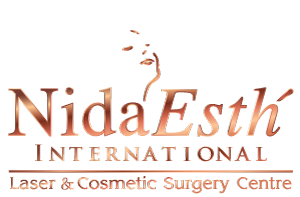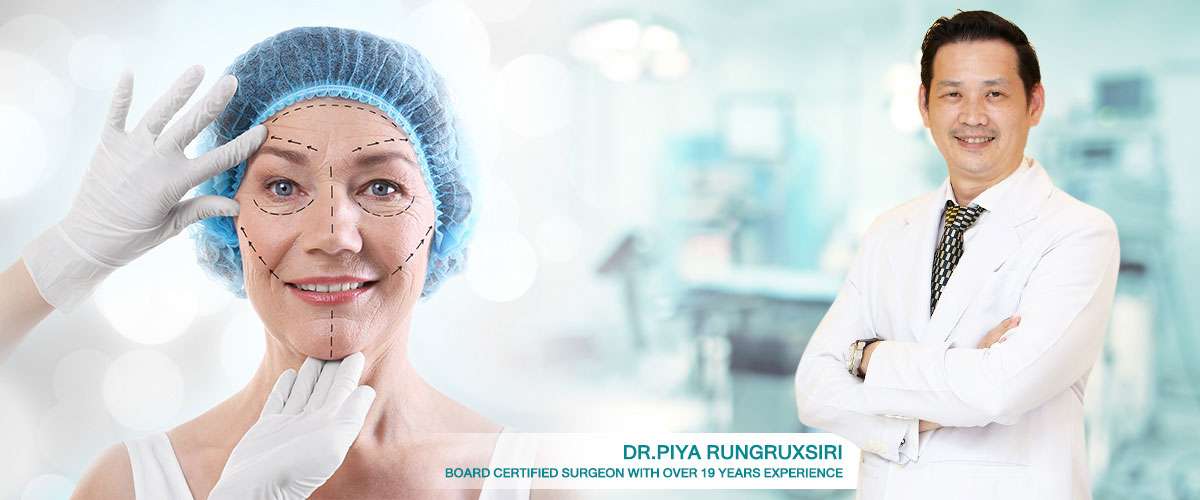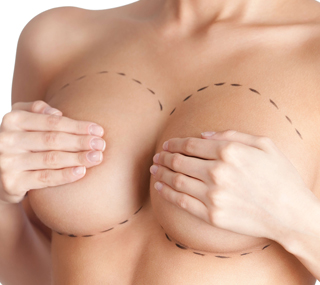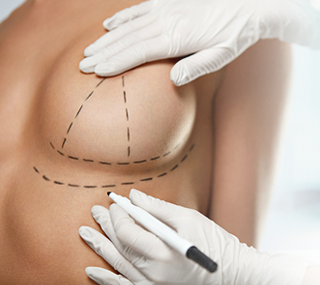As we age, our skin is not as tight as before since it also ages as well. When we are 20-30 years old, we have the tightest facial skin of our lifetime. But, once we are 40-50 years old, we would see differences such as sagginess and facial fat loss. Finally, when we are 50-60 years old, we are at the most suitable time for full face lift due to our skin condition at the time.

Why full face lift at Nida Esth’
- The expertise of a surgeon – Dr. Piya Rungruxsiri – who has a special technique of full face lift and more-than-19-year experience in surgical field.
- Anesthesiologists and nurse teams who have experiences in taking care patients and hospitalization both local and international
- Impressive patients who can confirm that they experienced very little pain and swollen. Moreover, there is no visible scar. The result is absolutely satisfying.
What is full face lift?
Full face lift or Rhytidectomy is a procedure that tightens our facial skin which can be divided into 3 parts
- Upper part is to tighten a forehead and eyebrows
- Middle part is to tighten sagging cheeks, lower eyelid areas and cheek grooves
- Lower part is to tighten sagging chin area both sides and in the middle (Double chin)
Patients can choose to undergo some or all parts depending on their problems and preferences.
Full face lift procedure can be combined with other procedures for the best result such as lower eyelid surgery, fat transferring, etc.
Who is suitable for full face lift?
People who have problems of sagging and loose facial skin at the age of 40 or above can choose to do either partial face lift or full face lift.
Where to start once decided to do face lift?
A face-to-face consultation with a plastic surgeon is the first step to acknowledge the information about face lift and how it can solve the problems.
The plastic surgeon usually analyzes problems of patients and decides which parts – upper, middle or lower parts – should be done. Patients will be acknowledged and feel no pressure during the consultation which can be concluded the followings
- Patient’s expectation and evaluation by the plastic surgeon
- Other options of face lift surgery
- Result of face lit surgery and risks of complication after the surgery
- Treatment courses recommended by the plastic surgeon
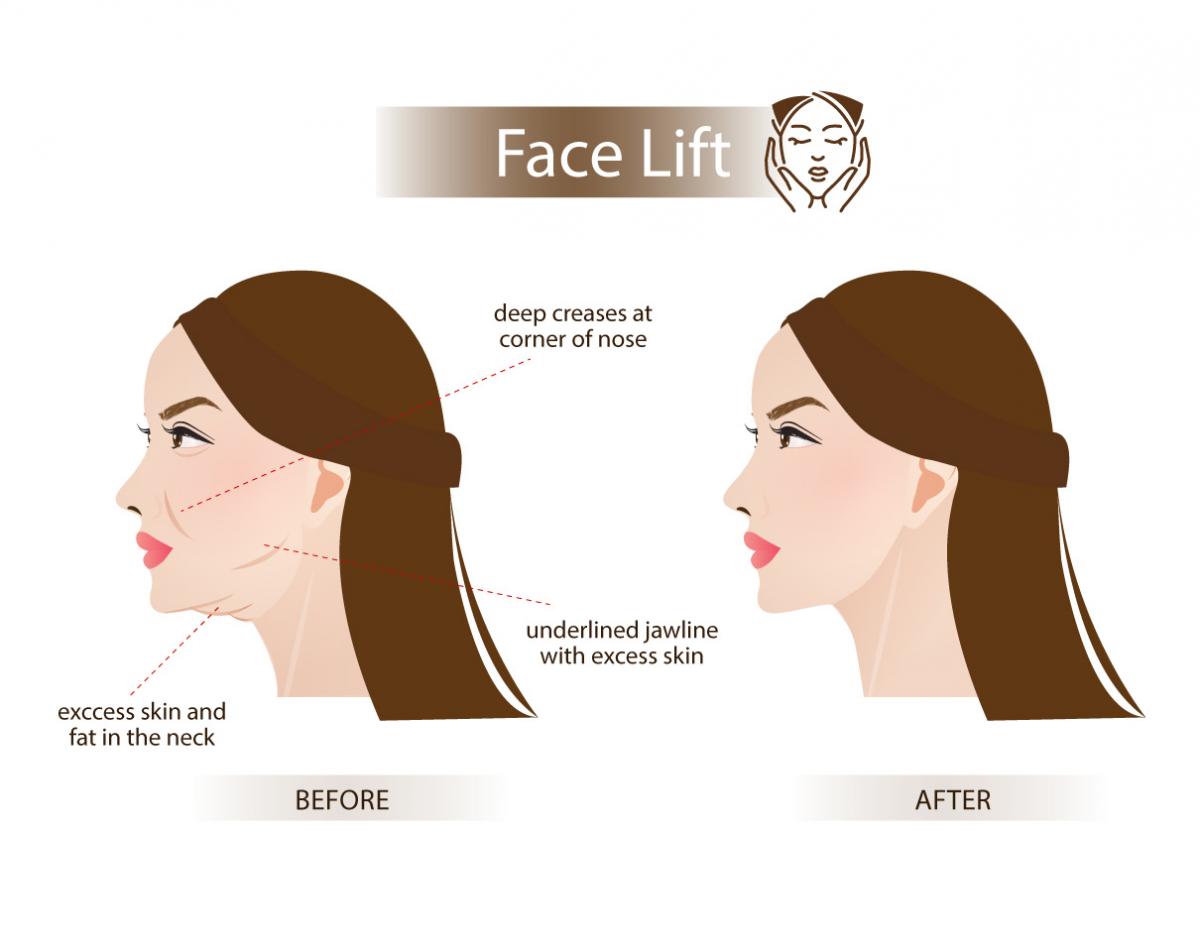
*Note: The result may vary depending on individuals
Facelift Process
Face lift is to adjust facial structure and nearby areas. Face lift is the most effective surgical procedure to fix sagging facial skin problem. The result is better than non-invasive laser treatments since the laser treatments can only fix the sagginess but cannot create a result which is as satisfying as face lift surgery.
Methods of surgical face lift start from
- An anesthesiologist will perform general anesthesia process in the first step of the procedure
- Incisions will be made, starting from a hair line, temples, in front of ears, the back of ears and hair line at the back accordingly.
- The plastic surgeon then pulls out facial skin to cover and cut out the rest and finally stitches the wounds
- The plastic surgeon may create a wound under chin in case of neck lift surgery
- Moreover, there is a technique called Short Scar Face Lift where the wounds start only from hair line at temples down to the front of ears.
As mentioned above, there must be an evaluation from the plastic surgeon about sagging problems whether we need to fix only some or all parts of a face and there should be any other alternatives or not such as injections, fat transfer, eyelid surgery and chin liposuction.
Preparations before face lift surgery
The plastic surgeon usually explains in detail about the processes of the procedure before the surgery. Patients should know the followings
- Facts before face lift surgery, evaluation, analysis and treatments
- Dates of treatments and follow-ups
- Information about anesthesia
- Post-operation care and follow-ups
Moreover, patients are asked to sign a consent form for surgery to assure that patients understand procedures, possibilities and risks of complications after surgeon’s explanation. Risks of face lift can be blood clot under skin, infections, bruised nervous system and unhealthy recovery process. All surgeries are risky in terms of anesthesia. All risks are acknowledged by patients before signing a consent form.
Follow-ups after face lift
After the surgery, patients are bound with elastin fabric or bras that support a head and a face to reduce swollen during recovery process. A tiny tube might be inserted under skin to release blood clot.
- Post-operation care after face lift surgery and blood drains
- Take medications to help recovery process and infections
- Post-operation care and overall health
- Follow-ups with a plastic surgeon
Recovery Process
- At the first stage after the surgery, there might be bruises, swollen and pressure feelings around incisions. Medications may be prescribed to relieve the conditions.
- Put your head straight upward until the conditions mentioned above are gone.
- Mild activities can be done as usual around 2-3 days after the surgery. Wounds get better after approximately 5-10 days and stitching off will be done after that.
- Sunscreen should be applied and light make-ups can be applied as well to cover redness.
Result
After the face lift surgery, patients can feel the youthfulness of their face and the sagginess that is reduced. The result may be more visible after a few weeks and may take years for the wounds to be completely healed. Patients should avoid sunlight by applying a sunscreen which makes the result lasts longer.
Surgery package
- Hospital accommodations
- OR and recovery room charges
- Medical equipment and supplies
- Preoperative routine lab test
- Pre op medicines, anesthesia, medical gas
- Professional fees (surgeons, anesthesiologist, nurses)
- Post op care
- Transportation (hotel-hospital-hotel)
- Mobile SIM card
